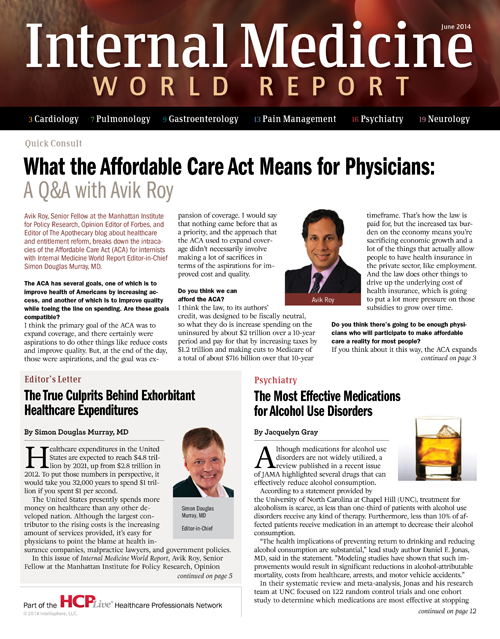The True Culprits Behind Exhorbitant Healthcare Expenditures
Internists must resist taking as much as they can carry from the current healthcare system just because they can get away with it.

Simon Douglas Murray, MD
Editor-in-Chief
Healthcare expenditures in the United States are expected to reach $4.8 trillion by 2021, up from $2.8 trillion in 2012. To put those numbers in perspective, it would take you 32,000 years to spend $1 trillion if you spent $1 per second.
The United States presently spends more money on healthcare than any other developed nation. Although the largest contributor to the rising costs is the increasing amount of services provided, it’s easy for physicians to point the blame at health insurance companies, malpractice lawyers, and government policies.
In this issue of Internal Medicine World Report, Avik Roy, Senior Fellow at the Manhattan Institute for Policy Research, Opinion Editor of Forbes, and Editor of The Apothecary blog about healthcare and entitlement reform, discusses these mounting costs in the context of the Affordable Care Act (ACA). According to Roy, the administrative costs attributable to large health insurance companies amount to only 1-2% of healthcare expenditures. Additionally, insurance companies operate on a 5% profit margin, which is small compared to the 16% profit margins of pharmaceutical companies, 12% margins of biotechnology companies, and 13.6% margins of medical equipment suppliers. Despite the exorbitant salaries paid to healthcare executives, the overall burden to the system isn’t nearly as high as one would expect.
As a percentage of the total healthcare expenditures, the direct cost of malpractice is rather small. However, the indirect costs total as much as $1 trillion a year for defensive medicine that includes unnecessary testing, X-rays, consultations, prescription drugs, and office visits. Before physicians begin to complain too strenuously about this, they should recall that they are the principal beneficiaries in the form of paid fees.
Since just about every patient has been affected by the increasing costs of prescription drugs, “big pharma” has become the lightning rod for consumer anger. But the truth of the matter is the overall rate of prescription drug costs has slowed, largely due to the extensive use of generic medicines. However, once generics are factored out, it becomes quite obvious that the costs of brand-name drugs and biologics have risen sharply, far outpacing the rate of inflation.
Despite the rapid spike in drug costs, pharmaceutical sales only account for 10% of healthcare expenditures. The largest slice of the expenditure pie stems from physician and hospital services, so it is understandable why reformers have chosen to target them. However, this has led to intrusive measures such as precertification, concurrent hospital reviews, retrospective denial of services, and audits on care quality, which all demoralize physicians and increase administrative costs that disproportionally affect primary care physicians (PCPs).
Many doctors have begun to believe it would be better to establish a single-payer system patterned after Medicare. After all, Medicare has historically been kind to physicians by paying bills quickly and without much scrutiny. However, Roy points out that a single government-run system would prove to be as compassionate as the Internal Revenue Service (IRS), as cost-conscious as the US Army, and as efficient as the US Postal Service (USPS). Such a system would also prevent competition in the marketplace, since it would control the amount physicians would be paid for each service, as well as dictate who receives a license to practice medicine and what conditions are required to maintain it.
Fortunately, one bright spot is retainer-based practices, which are growing slowly but surely through a variety of economic models. Such practices charge patients an added fee for services while limiting the size of their patient populations, thus guaranteeing personalized care with reduced costs to the system. Currently, private health insurance companies are considering methods to incorporate these practices into mainstream plans because they recognize this savings benefit.
Although the amount of services provided comprise one of the fastest-growing segments of healthcare expenditures, physicians are not the only culprits. Hospitals aren’t fooling anyone in their attempts to monopolize local markets by buying up practices, which allows them to raise rates and pay their workers less. Because hospitals employ large numbers of community residents, they have traditionally been in a good position to deflect legislative scrutiny, but this needs to change.
Furthermore, the federal government must consider how its current policies disproportionately hurt PCPs by reducing salaries and increasing administrative burdens, which ensures the projected shortage of PCPs by 2020 will occur. Medical students see the writing on the wall and show little interest in primary care, instead pursuing the “roads to success” paved by radiology, orthopedics, anesthesia, and dermatology.
It is fairly easy to understand how we got here. Common sense should have dictated that handing out signed blank checks to providers would cause a run on the bank. Now, the difficult part will be finding a solution that is fair and equitable to all players without dramatically reducing the quality of care. PCPs know all too well that this process is painful, but it will be less so if everyone pulls their weight. In this sense, PCPs must resist taking as much as they can carry from the healthcare system just because they can get away with it.
Simon Douglas Murray, MD
Editor-in-Chief
Simon Douglas Murray, MD, is Clinical Assistant Professor of Medicine at Robert Wood Johnson Medical School in New Brunswick, NJ, and Senior Attending in the Department of Medicine at the University Medical Center at Princeton. He has been affiliated with the MDVIP physicians network since 2006 and currently practices internal medicine in Princeton, NJ.
